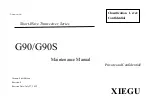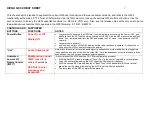
6 Using the vLoc-5000
Page 45 of 57
the red filling is at a lower level in the Guidance Compass in these areas. The measured distortion
approaches a peak about in the same place as the signal strength peak, indicating the presence of another
conductor.
Distortion Alert Sample Scenario
In this particular case, the centerline estimate is not significantly biased, though the depth estimate is less
accurate.
NOTE
If the Signal Select modulation is used, the problem may occur that the current
flow direction displayed on the receiver is opposite to the actual flow direction in
the target line. Thus the following test must be carried out prior to every
measurement using Signal Select:
Choose a location where the target line can be clearly identified and check the
displayed current flow direction. If the shown direction is wrong, turn the Signal
Select pincer or interchange the connection lines. As a result, the displayed and
the actual current flow direction should match each other. Now the measurement
can be started.
Distortion Alert
Distortion creates phase anomalies in the signal, which can be detected at the receiver and compared to a
phase reference imparted at the transmitter. This reference is set by Signal Select modulation for every active
frequency imparted at the transmitter. The transmitter must be in direct (conductive) connection mode, and
Signal Select modulation must be switched on for each frequency (this is the default). Even if multiple
simultaneous outputs are on, any or all can be selected to carry the modulated output. For each transmitter
output that is Signal Select modulated, there is an independent control loop to ensure that the phase
reference is zero.
The level of distortion in the field is proportional to the level of the red background in the Guidance Compass.
It is not necessarily true that when the Guidance Compass background is predominantly red that a poor
locate results. The Distortion Alert feature is just that, an alert that a non-ideal magnetic field is detected. In
some cases the conductor that carries the bleed over current may lay directly on top (in the same duct) of the
target conductor. In this case, the predominant current that is detectable at the surface is from the bleed over
line, but the actual centerline estimate is correct.
6.3.10 Signal Direction Precision Identification
Some models in the vLoc series of locators contain a feature called “SIGNAL DIRECTION”. This feature is
used to verify if the line being located is the line to which the transmitter has been connected.
When a transmitter is connected to a target line the signal travels along it and finds the easiest way to travel
back, usually via the ground and ground stake. However, very often the signal will travel back along adjacent
cables or pipes as these can offer an easier route.
[email protected] | 13309 Beach Ave. Marina del Rey, CA 90292 | Phone: 800-WCT-PROD (800-928-7763) | Fax: 310-306-9343














































